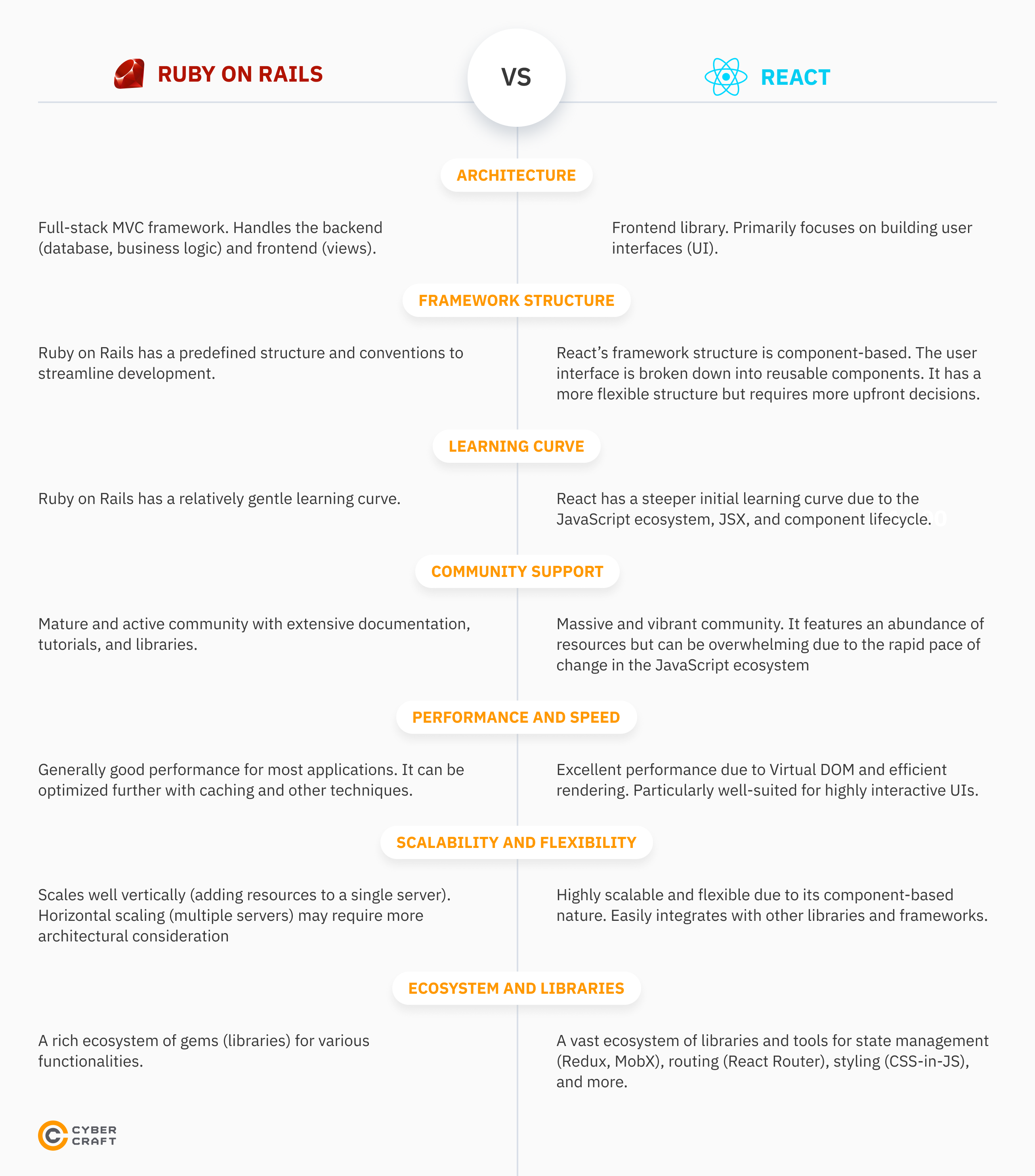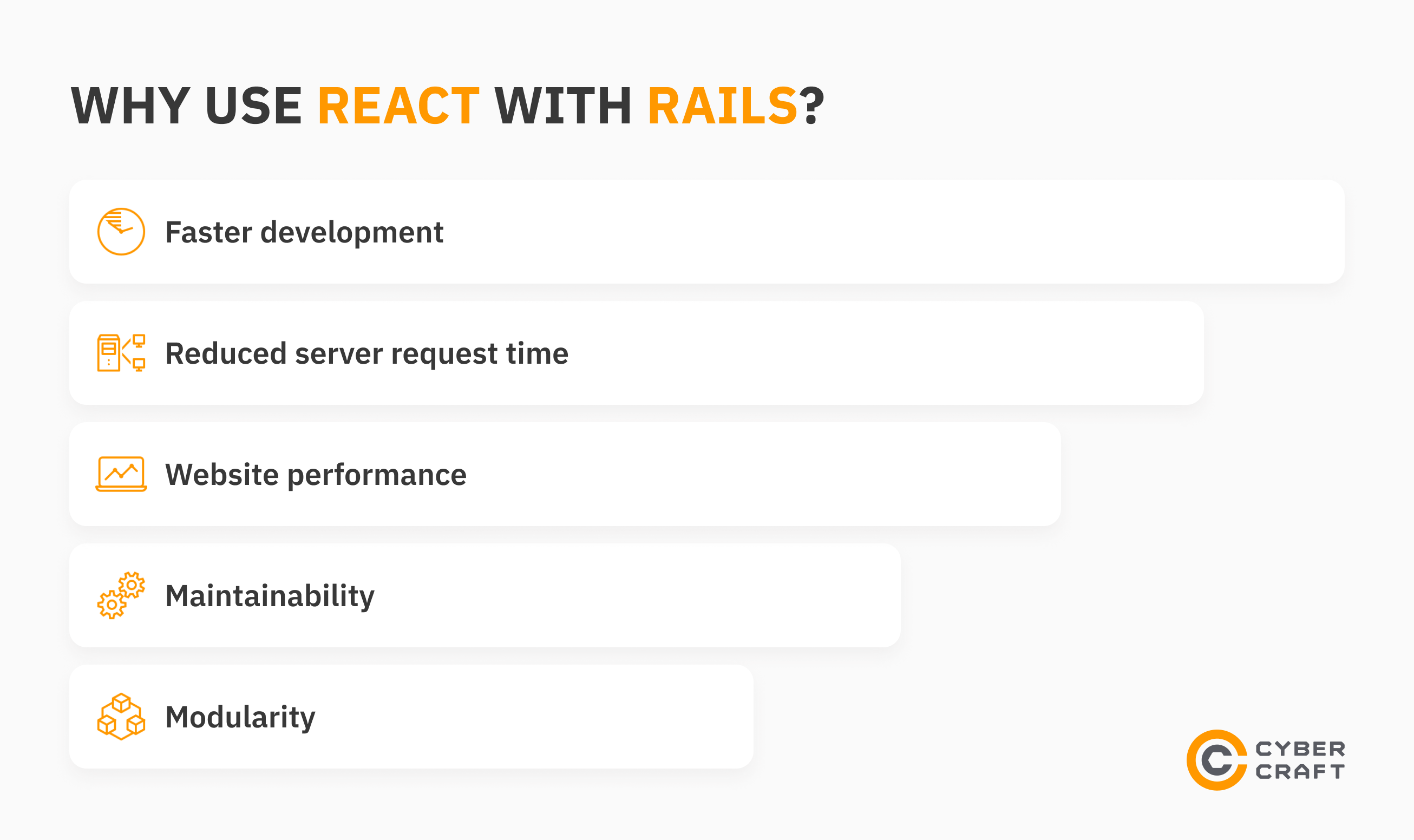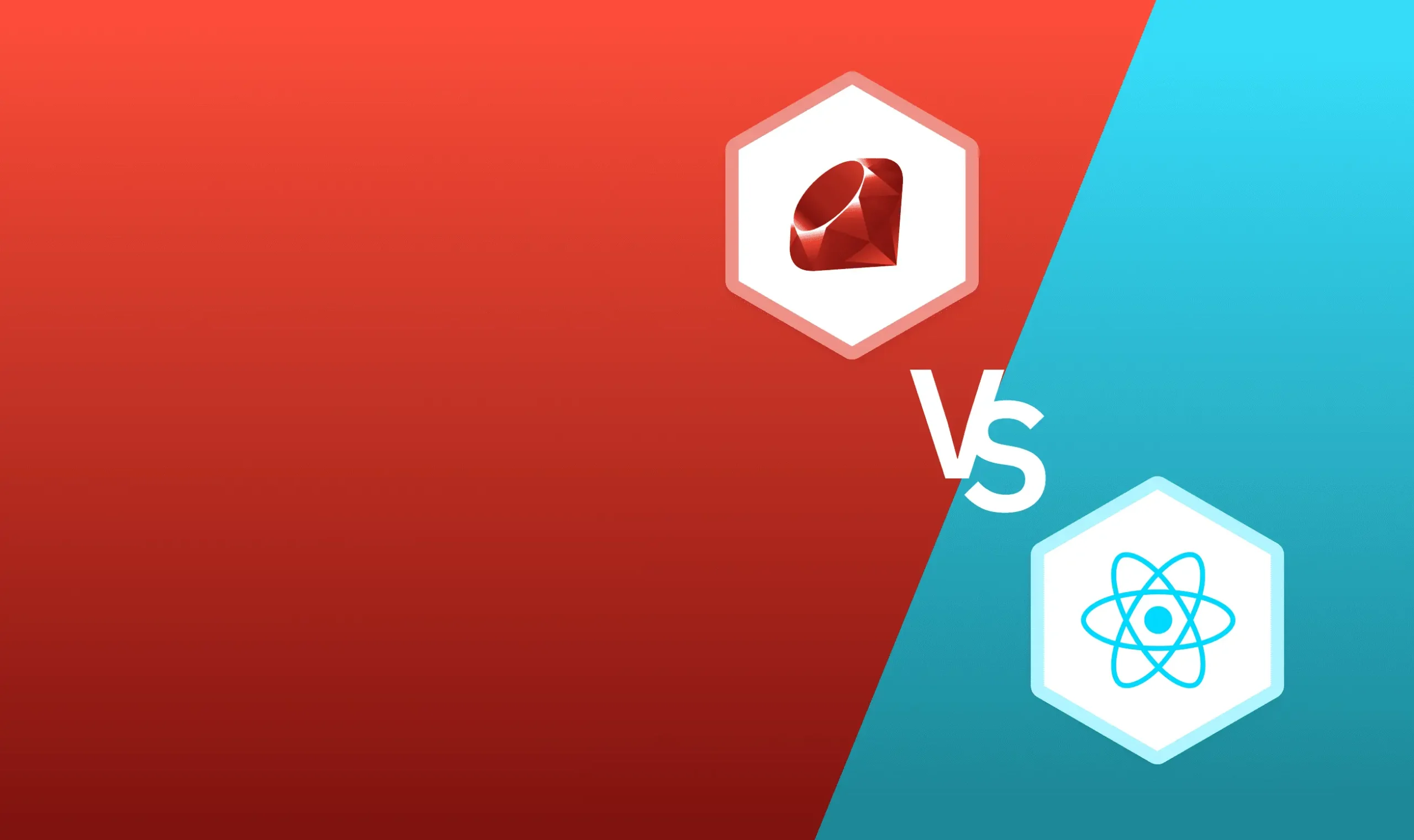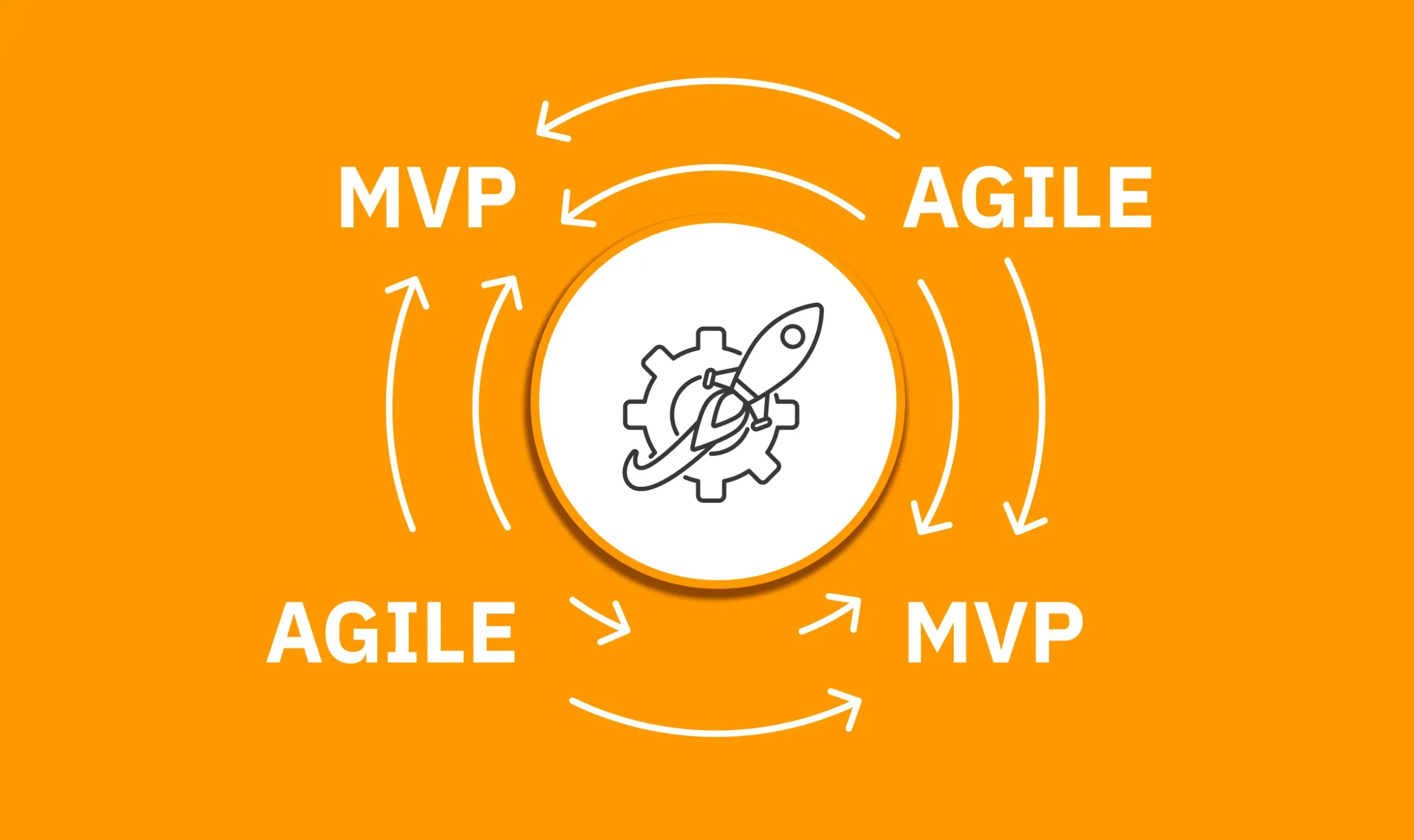The React vs. Ruby on Rails debate is popular among web development enthusiasts. Picking the appropriate tools is crucial in the ever-changing field of web development. React with Ruby on Rails are two technologies known for their ability to rise to the occasion during web development processes. With their special combination of frontend flexibility and backend robustness, this dynamic pair allows developers to build great web applications.
Consequently, this article will explore the benefits and drawbacks of using React on the front end and Ruby on Rails on the back end. We will also discuss the ideal situations for using each tool and how best to integrate them. Armed with the information in this guide, you can easily decide whether to use them for web application development by checking to see if they fit the needs of your specific project.
What is Ruby on Rails?
Designed in the Ruby programming language, Ruby on Rails (also known as Rails or RoR) is a strong, open-source web application framework. Designed by David Heinemeier Hansson, Ruby on Rails is built with a focus on fast development, which is responsible for its growing popularity.
The following are some top features of Ruby on Rails that anyone looking to compare Ruby on Rails vs. React can consider:
- DRY by Rails. This is one of the top features of Ruby on Rails; it helps to improve development efficiency and encourages simple and reusable code, hence lowering duplication.
- Ruby on Rails has a set of accepted rules and “sensible defaults”, which decreases the required level of configuration to bring a project operating.
- Ruby on Rails is designed to streamline database interactions. Ruby on Rail’s Object-Relational Mapping technology allows users to work with objects without running SQL searches.
- Ruby on Rails provides tools and frameworks for writing units, integration, and functional tests. Consequently, this helps to improve and encourage the use of tests.
Furthermore, Rails uses the Model-View-Controller (MVC) architectural paradigm that arranges code and divides concerns. This is highly useful in the creation of scalable and maintainable web applications.
When to Use Ruby on Rails?
Although Ruby on Rails is fit for many kinds of web projects, it shines especially in the following situations:
- Startups and MVPs. Rails lets you rapidly prototype and create minimum viable products (MVPs), enabling a fast market test of your idea.
- E-commerce. Rails provides tools and frameworks covering catalogue management, payment handling, online store creation, and more.
- Social networks and platforms. The Rails design fits quite well for developing applications with complicated interactions and many users.
- Content management systems (CMS). Ruby in rails is the best fit for building customizable and versatile CMSs that fit one’s specific company.
Overall, Ruby on Rails can be a great option if you require a dependable, quick, time-tested framework for web application development.
What is React?
React (React.js or ReactJS) is a free and open-source JavaScript tool designed especially for single-page apps. Originally developed by Facebook (now Meta), React has gained great popularity for its component-based architecture, effective rendering, and developer-friendly approach. When comparing React Native vs. Ruby on Rails, it is crucial to pay close attention to the React algorithm and its core features. Some main features of React include the following:
- One of the first things to notice when comparing React vs. Ruby on Rails is that React apps are constructed from self-contained modules. This allows React apps to manage their state and render, independently of one another;
- React apps also allow for reusability, modularity, and simpler testing of codes;
- React uses a virtual model of the real Document Object Model (DOM). This simply re-renders the required items and compares the virtual DOM with the real DOM to enable effective modifications;
- React also features a syntactic extension, enabling users to create JavaScript code resembling HTML. The component definitions created in JavaScript JSX are more readable and easy to understand;
- React enforces a one-way data flow, which simplifies reasoning about how data changes spread through your application and lowers unanticipated side effects;
- React handles the updates and rendering for you. This is not the case with imperative methods, whereby you physically control the DOM.
Now that you fully understand the core features of React and Ruby on Rails, it will be a lot easier to compare Rails vs. React. Overall, React allows users to build sophisticated user interfaces from individual, small bits of code known as “components”. Also, the ability to reuse these codes, several times, throughout the application enhances speed and allows for easier maintenance of the application.
Comparison of Ruby on Rails and React
Although Ruby on Rails and React are strong tools in web development, they have different uses and shine in different spheres. Selecting the appropriate technology for your project depends on knowing the main use cases of React vs. Ruby on Rails:
 Overall, the comparison of React Native vs. Ruby on Rails shows that both are great tools for building web applications. However, they differ slightly in their specific use cases. Consequently, the ideal tool for any web development process depends on the project’s specific requirements.
Overall, the comparison of React Native vs. Ruby on Rails shows that both are great tools for building web applications. However, they differ slightly in their specific use cases. Consequently, the ideal tool for any web development process depends on the project’s specific requirements.
Key Considerations
When choosing the perfect platform for your workflow and deciding between Ruby on Rails vs. React, the following are some key factors to consider:
- Project scope. Rails are perfect for full-stack projects where quick development is given top attention. However, React excels in creating interactive, sophisticated user interfaces or when frontend and backend development must be split apart;
- Team expertise. Ruby on Rails is a great fit for a team that is competent with Ruby. But React is usually the better option for teams with strong JavaScript expertise;
- Performance requirements. React may be a better choice if your application demands very high performance for intricate UI interactions.
Overall, both options guarantee convenience and boost the workflow; the main thing is to decide what option between React Native vs. Ruby on Rails suits your web development goals.
When to Use React with Ruby on Rails?
While both Ruby on Rails and React have their individual strong points, combining them offers more improved functionality. Overall, the main reason for comparing Ruby on Rails vs. React is not just to pinpoint their difference, but to see how to integrate and use them together. This synergy uses both of their strengths so that you may create complex applications with both efficiency and simplicity. The following are the best situations to use React with Ruby on Rails:
- For Scalability. React and Rails both present first-rate scalability choices. React’s component-based design lets the frontend be horizontally scaled; Rails can be scaled either horizontally or vertically depending on your needs;
- When Building Modern Web Apps with Rich UI. React’s component-based architecture and effective rendering fit your application if it requires a highly interactive and dynamic interface. React is left to produce a seamless, interesting frontend experience, while Rails can manage backend data and business logic;
- For Single-page Applications (SPAs). React shines in creating SPAs, in which content updates dynamically without full page reloads. As the API backend, rails can provide React components data as needed, so guaranteeing a quick and responsive app;
- Frontend Logic. Complicated React’s declarative approach and component reusability can greatly ease development and maintenance when the UI of your app calls for complicated interactions, real-time updates, or sophisticated state management;
- For Building Hybrid Mobile Applications. React Native lets you reuse a large amount of your React codebase, so saving valuable development time and effort if you intend to build a mobile app alongside your web app;
- When working with rails backend. Integrating React for the front end will help you progressively improve any Rails application you already have with a strong backend basis. This lets you modernize the UI without totally rewriting your current code.
Overall, when you need a strong backend, a modern and interactive frontend, and the flexibility to scale your application as it develops, React and Ruby on Rails present a compelling solution. This combo will enable you to create maintainable, interesting, and high-performance web apps that satisfy today’s consumer needs.

How to Integrate React with Ruby on Rails?
Integrating React with Ruby on Rails may be a complicated process that requires deep attention and skills. For smooth integration of React with Ruby on Rails, you may use the guide below:
-
- Project setup. Create a new Rails application or use an existing one and use the –webpack=react flag to configure Webpack for seamless integration with React;
- Add react-rails gem. To integrate the react-rails gem into your project’s configuration file, execute the specific commands to install it and generate boilerplate files for React component rendering within Rails views.
- Craft your React component. Create a new JavaScript file with a.jsx extension and define your first React component using JSX syntax, encapsulating the structure and behavior of a specific UI element.
- Embed React in Rails views. The React component can be displayed seamlessly within a Rails application using the react_component helper function in the.html.erb file.
- Launch the development environment. Test your integrated setup by launching the Rails server and the Webpack development server, and verify that your React component is correctly displayed and functioning as intended.
Use tools like Redux or MobX for managing complicated application states, React Router for client-side navigation, create API endpoints for data from your Rails backend and maximize your React assets during production. Ensure they are part of the last deployment, so the user experience is seamless when combining React with Ruby on Rails.
Why Use React with Rails?
Using Ruby with RoR opens multiple possibilities for your working process. Below, you can check the TOP 5 reasons to use a combination of React with Ruby on Rails.

Faster Development
React with Ruby on Rails can improve frontend performance and site load times, which can lower the number of people who leave the site. And since everything is in one place, it is also easier to make changes to the codes.
If you want to add new features quickly and easily, like a search or an online store, you can make a new API endpoint or script that runs on your server. Each change was perfectly synced between the back and front ends without extra work. In short, less friction leads to faster and more useful growth.
Reduced Server Request Time
Since JavaScript runs on the browser and calls for less server rendering, RoR with React lowers server request times. This lowers server load at the same time as cutting the demand time between client and server.
Without affecting your application’s performance, this enhances its user experience. Reduced application load time raises conversion rates for e-commerce websites, enhancing their appeal to users and generating more income.
Website Performance
Regarding the user experience of your website, performance rules everything. You need a framework that allows you to maintain the satisfaction of end users. Therefore, ideal partners are a JavaScript framework such as React and a Ruby on Rails web application server.
While React can be used alone, its adaptability lets it coexist with other frameworks and platforms. It gives each site component total autonomy over how they interact without compromising the rest of your page.
Maintainability
Ruby on Rails is simpler to use and maintain than JavaScript frameworks. Consequently, it saves developers time since less code has to be created, reducing the time spent building pointless components and resulting in fewer flaws in your software.
Moreover, React with Ruby on Rails simplifies tasks by offering pre-made components that allow quick and easy building of web apps.
Most of the coding work is reduced by pre-built elements, including form fields, calendar views, models, and others, freeing you to concentrate on what you do best: creating beautiful interfaces that interact with people while generating income.
Modularity
One of the top benefits of using React with Ruby on Rails is its modularity. While it may be seemingly challenging for novice developers looking to build their entire project with one framework, applying several frameworks can help an application to be more flexible.
You might apply them in different ways since they are independent frameworks devoid of clear rules for their interaction. For instance, when you add new pages to your website, you might use a single-page app for some and a regular page for others.
Final Thoughts
Rails vs. React are two powerful tools that offer unique advantages depending on the project’s requirements. Rails is a full-stack framework that provides a solid foundation for server-side logic, database management, and structured development, while React excels in creating dynamic, interactive user interfaces.
For projects requiring rapid development, convention over configuration, and a well-defined structure, Ruby on Rails is a solid choice. For high-performance user interfaces, complex interactions, or the flexibility to build a separate front end, React is the ideal choice. Combining React with Rails is a winning strategy for projects requiring a robust and modern backend.
As web technologies advance, React vs. Ruby on Rails are well-positioned to adapt and remain essential tools for building the next generation of web applications. The best choice depends on project goals, team expertise, and desired user experience. Understanding the strengths and weaknesses of each technology can help make informed decisions and build powerful and user-friendly applications.
FAQ
Yes, React and Ruby on Rails can be rather powerfully merged. React produces an interactive and dynamic user interface; Rails manages the backend logic and data. Building contemporary web applications that call for both a strong backend and a rich frontend experience calls for this popular choice.
Updates on rails could call for changes in gems or backend code. React changes sometimes impact frontend components, thus, refactoring could be necessary. The key is compatibility; careful testing and adherence to the best standards help to minimize the disturbance of legacy projects.
Considering Rails vs. React, Ruby on Rails is a full-stack framework for building web apps. It handles both backend (server-side) and frontend (client-side) logic. React is a front-end JavaScript tool that is only used to make user interfaces. Rails is a more structured environment than React, which lets you make dynamic user interfaces with more freedom and use a component-based architecture.




